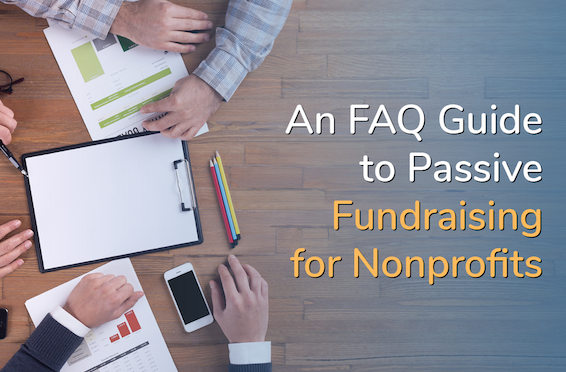
Imagine this: Your nonprofit is in the midst of several key projects and is planning to launch a new community program, all of which will greatly benefit your mission. When you combine the associated expenses with the costs of operating your organization day-to-day, you determine that you’ll need to add new fundraisers to your calendar to fund all of these initiatives.
However, you quickly realize there are several obstacles to starting a new fundraising campaign, including team time, resource availability, and donor fatigue. So, you ask yourself, “What if there was a solution that overcame these challenges and could turn into a steady revenue stream for my nonprofit?”
Fortunately, there is an answer—passive fundraising! In this guide, we’ll provide an overview of this type of fundraiser by answering three of the most common questions about it. Let’s dive in!
What is passive fundraising?
ShopRaise’s guide to passive fundraising defines the term as “any campaign in which supporters generate revenue for charitable causes as they go about their daily activities, often without spending any money they wouldn’t have otherwise.” This makes them extremely convenient to participate in, meaning that you have to ask very little of your already busy and generous supporters.
Although the individual contributions from most passive fundraisers are relatively small, they add up over time to make a significant difference for your nonprofit. Plus, these funds can come in year-round and are unrestricted, so you can put them toward any area of your organization’s operations, including administrative needs or other fundraising activities.
How much work does passive fundraising involve?
The “passive” aspect of passive fundraising refers to two things: supporters don’t have to go out of their way to participate, and the campaigns essentially run themselves once your nonprofit sets them up. But even though the fundraisers themselves are fairly hands-off, there are a few additional actions your organization needs to take to make them succeed, including:
- Marketing. Naturally, supporters can only contribute to your passive fundraisers if they know they’re happening! Leverage your nonprofit’s various digital and print marketing channels (such as your website, email, social media, and flyers) to spread awareness of your campaigns and provide instructions for participation.
- Thanking participants. If supporters know that your nonprofit appreciates their passive fundraising contributions, they’re more likely to keep engaging with your campaign. Establish a regular communication cadence with active participants to thank them for their continued involvement and explain the impact of their support to demonstrate their value to your organization.
- Tracking data. As NPOInfo’s nonprofit data collection guide explains, gathering concrete information on your fundraising campaigns (including passive fundraisers) can help you monitor your progress and improve your strategy over time. To accomplish this, track metrics like participation rates, supporter acquisition and retention, total revenue raised, and conversions from each marketing channel.
Although all successful fundraisers involve these peripheral activities, they’re often easier to navigate when you don’t have to be actively involved in managing the campaign itself. Of course, events and other large-scale campaigns still have a place in nonprofit revenue generation—passive fundraising is simply meant to be a low-effort, high-reward supplement in between those larger fundraisers.
What are the best passive fundraisers for nonprofits?
There are a variety of passive fundraising campaigns your organization could incorporate into its strategy, so weigh your options and choose the ones that best align with your needs and your supporters’ preferences. As a starting point, let’s look at three of the most popular ideas.
Online Shopping Fundraisers
Online shopping fundraisers allow supporters to contribute a portion of their everyday purchase totals at participating e-commerce businesses directly to your nonprofit. This way, they can shop more ethically and support your mission without spending any extra money or taking time out of their daily lives.
To get started, all your organization needs to do is partner with an online shopping fundraiser platform. Look for a program that will:
- Walk you through the onboarding process and answer questions along the way.
- Handle all negotiations with retailers on your nonprofit’s behalf.
- Create a branded landing page and marketing materials to help you spread the word about your campaign.
- Set up a dashboard where you can view real-time fundraising data.
- Provide relatively high commission rates (up to 10% depending on the retailer).
- Do all of this at no cost to your organization!
Once your fundraiser is up and running, supporters simply need to download your fundraising platform’s app and use it while shopping online. They’ll pay the same prices they normally would, have access to any applicable coupon codes or discounts, and contribute directly to your organization with no additional effort required.
Gift Card Fundraising
Another way your nonprofit’s supporters can shop for your cause is through gift card fundraising. Similar to an online shopping fundraiser, they’ll purchase digital gift cards to participating retailers through your organization’s online gift card store, and a portion of each purchase goes directly to your mission.
Some online shopping fundraiser platforms have gift card fundraising capabilities built in so your nonprofit can run both campaigns for free at the same time. While some supporters who buy gift cards will want to give them to friends and family as presents, others may use them to pay for purchases through your online shopping fundraiser, thereby contributing even more to your mission!
Additionally, you’ll get the most traction from your gift card fundraiser if you launch it in November since supporters will likely be thinking about gift-giving for the holiday season. However, you should still leave your gift card store open year-round so supporters can buy gifts for birthdays and other special occasions when they need them, as well as cards to use for their own everyday purchases.
Matching Gifts
Matching gifts are different from the other passive fundraisers we’ve discussed so far because instead of being based on supporters’ purchases, they increase the impact of the gifts donors were already planning to make—without asking them to give more out of their own pockets.
When a supporter who works for a company with a matching gift program makes a donation and submits a match request, their employer will also contribute to your nonprofit, usually matching the original gift at a 1:1 ratio. This means that even if the donor only planned to give $25, they’ll make a $50 impact on your mission!
To make this fundraiser easy for your organization, invest in a matching gift database and embed it directly into your online donation page so donors can quickly check their eligibility. If the database has auto-submission capabilities, all they’ll need to do to submit their match request is enter their work email address, and the software will handle the rest!
The passive fundraising ideas above are just three of the many possibilities your nonprofit can choose from. No matter what campaigns you launch, remember to focus your efforts on marketing, thanking supporters, and tracking results to ensure success. Happy fundraising!
Korri Piper, Sales and Marketing Consultant & Director of Vendor Relationships at ShopRaise – Bio
 Relationship director, project manager, writer and general life enthusiast. Let me tell you how online shopping can solve the world’s problems.
Relationship director, project manager, writer and general life enthusiast. Let me tell you how online shopping can solve the world’s problems.

















 I can’t wait to meet with you personally.
I can’t wait to meet with you personally.
Comments on this entry are closed.